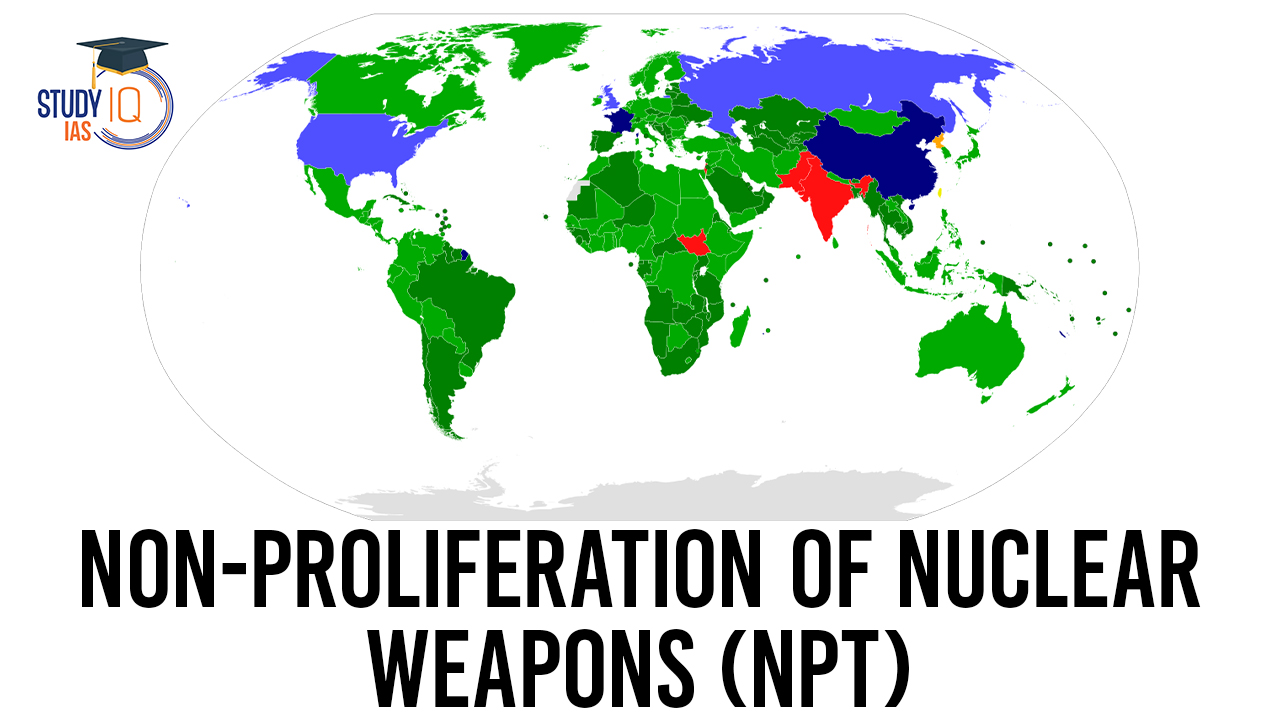Table of Contents
Context: Amid the heightened military tensions between Iran and Israel, Iran stated that its Parliament was preparing a Bill to potentially leave the Treaty on the Non-Proliferation of Nuclear Weapons (NPT).
The Treaty on the Non-Proliferation of Nuclear Weapons is a landmark international treaty aimed at preventing the spread of nuclear weapons and promoting disarmament. It was first opened for signature on July 1, 1968, and entered into force on March 5, 1970. The NPT is often considered the cornerstone of global efforts to prevent the further proliferation of nuclear weapons and to work toward nuclear disarmament.
Nuclear Non-Proliferation Treaty (NPT)
The Nuclear Non-Proliferation Treaty (NPT), signed in 1968 and force from 1970, is a landmark international treaty aimed at:
- Preventing the spread of nuclear weapons and technology.
- Promoting peaceful uses of nuclear energy through international cooperation.
- Working towards global nuclear disarmament.
Background
The Nuclear Non-Proliferation Treaty (NPT), established in 1968 and entered into force in 1970, is an international treaty with 191 member states as of my last knowledge update in January 2022. It aims to prevent the spread of nuclear weapons and promotes disarmament, recognizing five nuclear-weapon states (NWS) and non-nuclear-weapon states (NNWS). The NPT requires NWS to pursue disarmament, while NNWS commit not to acquire nuclear weapons but have access to peaceful nuclear technology. Criticisms include disparities among NWS and NNWS and challenges related to enforcement and preventing horizontal proliferation. The treaty remains vital in efforts to limit nuclear arms proliferation.
| Nuclear Non-Proliferation Treaty (NPT) | |
|---|---|
| Non-Proliferation | Prevent the spread of nuclear weapons to non-nuclear-armed states. Nuclear-armed states commit not to transfer nuclear weapons or technology to non-nuclear-armed states. |
| Disarmament | Promote nuclear disarmament among countries possessing nuclear weapons, leading to their reduction and eventual elimination. |
| Peaceful Use of Nuclear Energy | Recognise the right of signatory states to use nuclear energy for peaceful purposes (e.g., energy, medicine, research) and encourage international cooperation in these areas. |
Key Parties in the NPT
| Parties | Description |
|---|---|
| Nuclear-Armed States (P5) | Original nuclear-armed states: United States, Russia (formerly Soviet Union), China, France, United Kingdom. |
| Non-Nuclear-Armed States | Countries that don’t possess nuclear weapons and commit not to develop or acquire them (Non-Nuclear Weapon States – NNWS). |
Structure of the NPT
| Treaty Structure | Description |
|---|---|
| Preamble and Articles | NPT consists of a preamble and eleven articles outlining the provisions, obligations, and rights of the parties. |
| Regular Review Process | Member states hold Review Conferences every five years to assess treaty implementation and address concerns and challenges. |
Safeguards and Verification in the NPT
| Safeguards and Verification | Description |
|---|---|
| International Atomic Energy Agency (IAEA) | IAEA verifies that signatory states use nuclear technology for peaceful purposes and not for military use. |
| Safeguards Agreements | Required for NNWS to ensure the peaceful use of nuclear energy. |
List of NPT Members
Since its inception in 1970, the Nuclear Non-Proliferation Treaty (NPT) has garnered the support of 187 nations, making it one of the most widely ratified arms control agreements globally. The treaty’s core principles include preventing non-nuclear states from acquiring nuclear weapons and prohibiting nuclear-armed states from assisting others in their acquisition.
Additionally, it emphasises the pursuit of complete nuclear disarmament. The International Atomic Energy Agency (IAEA), an evolution of the United Nations Atomic Energy Commission, is responsible for verifying compliance with the treaty, which is then enforced by the United Nations Security Council.
Of the nine nations known to possess nuclear weapons, five—namely the United States, the United Kingdom, France, Russia, and China—are signatories to the NPT. The other four—India, Pakistan, Israel, and North Korea—have not signed the treaty and, therefore, are not parties to it.
Key Provisions of Nuclear Non-Proliferation Treaty (NPT)
The key provisions of the Nuclear Non-Proliferation Treaty (NPT) are as follows:
- Preventing Nuclear Weapons Proliferation: The NPT prohibits non-nuclear-armed states (NNWS) from acquiring or possessing nuclear weapons. This is aimed at preventing the spread of nuclear weapons to countries that do not already possess them.
- Disarmament: Nuclear-armed states (NWS), recognised under the NPT, commit to pursuing nuclear disarmament. While the treaty acknowledges their possession of nuclear weapons, it also obligates them to work towards the eventual goal of complete nuclear disarmament.
- Peaceful Use of Nuclear Energy: The NPT recognises the right of all states to develop and use nuclear energy for peaceful purposes, such as nuclear power generation and medical applications. It encourages cooperation and assistance in this regard.
- International Safeguards: The International Atomic Energy Agency (IAEA) is tasked with verifying and ensuring the peaceful use of nuclear technology following the treaty. This involves monitoring and inspecting nuclear facilities to prevent their diversion for military purposes.
- Non-Nuclear Weapon States’ Commitment: NNWS commit not to seek or receive assistance in the development of nuclear weapons. They also undertake to accept IAEA safeguards on their nuclear activities.
- Nuclear-Armed States’ Commitment: NWS pledge not to assist NNWS in acquiring nuclear weapons and to pursue disarmament in good faith, though no specific timeline is set for disarmament.
- Review Conferences: The NPT mandates periodic review conferences to assess the treaty’s implementation and to address any challenges or new developments related to nuclear proliferation and disarmament.
- Withdrawal Clause: The treaty includes provisions for states to withdraw from the NPT if they decide that their “supreme interests” are at risk, though such withdrawal is subject to specific procedures and consultations.
|
Article 10 of the Nuclear Non-Proliferation Treaty (NPT) – Withdrawal Clause |
|
India’s Stance on Nuclear Non-Proliferation Treaty (NPT)
India has had a unique and distinctive stance on the Nuclear Non-Proliferation Treaty (NPT). Here’s an overview of India’s position regarding the NPT:
- Non-Signatory: India has not signed the NPT. It decided not to join the treaty when it was first opened for signatures in 1968. The primary reason for this was India’s opposition to what it perceived as discriminatory aspects of the NPT.
- Discrimination Concerns: India has long argued that the NPT creates a divide between nuclear-armed states (the five recognised NWS under the NPT) and non-nuclear-armed states. India contends that this division is unfair and discriminatory, as it perpetuates a hierarchy of nuclear-armed and non-nuclear-armed states.
- Call for Universal Disarmament: India advocates for global nuclear disarmament. It believes that all nations, including the existing nuclear-armed states, should commit to complete nuclear disarmament. India’s position is that until this universal disarmament is achieved, the NPT does not provide a fair or equitable framework for addressing nuclear weapons issues.
- Security Concerns: India’s decision not to sign the NPT is also influenced by its security concerns, particularly regarding China, its nuclear-armed neighbour. India perceives the regional security situation as a factor in its nuclear policy.
- Nuclear Tests: India conducted its first nuclear test in 1974 and then a series of tests in 1998, which drew international criticism. These tests, along with India’s refusal to sign the NPT, further complicated its relationship with the treaty.
- Engagement with Non-Proliferation Regimes: While India is not an NPT signatory, it has sought to engage with various non-proliferation regimes and has expressed its commitment to responsible nuclear behaviour. It has also committed to a voluntary moratorium on nuclear testing.
- Nuclear Deal with the U.S.: In 2008, India reached a civil nuclear cooperation agreement with the United States, which allowed for the transfer of civilian nuclear technology and materials to India despite its status as a non-NPT state. This agreement was a significant development in India’s nuclear diplomacy.
Drawbacks of Nuclear Non-Proliferation Treaty (NPT)
The Nuclear Non-Proliferation Treaty (NPT) has drawbacks and criticisms:
- Slow Disarmament: NWS progress towards disarmament is sluggish, with no clear timeline.
- Discrimination: NPT is seen as creating a divide between NWS and NNWS, leading to calls for more equitable disarmament.
- Lack of Accountability: The treaty lacks mechanisms to hold NWS accountable for disarmament commitments.
- Non-Signatory States: India, Pakistan, Israel, and North Korea possess nuclear weapons outside the NPT framework, highlighting challenges in preventing horizontal proliferation.
- Vague Withdrawal Provisions: The NPT’s withdrawal clause can be exploited due to its vagueness.
- Nuclear Testing: The treaty’s effectiveness in preventing nuclear testing is limited.
- Geopolitical Realities: Geopolitical tensions can undermine disarmament efforts.
- Middle East Resolution: Progress towards a nuclear-weapon-free zone in the Middle East is slow.
- Technical Challenges: Modern delivery systems and technologies aren’t explicitly addressed.
- Enforcement Challenges: Challenges related to IAEA access and enforcement mechanisms can hinder effectiveness.
Challenges and Criticisms of the NPT
| Challenges and Criticisms | Description |
|---|---|
| Concerns | Concerns related to nuclear disarmament progress, nuclear modernisation, and potential treaty withdrawal by some states. |
| Disarmament vs. Non-Proliferation | A contentious issue: balancing disarmament commitments by nuclear-armed states and non-proliferation commitments by NNWS. |
Consequences if Iran Exits the NPT
- Loss of IAEA Oversight: Iran would no longer be legally obligated to allow IAEA inspections of its nuclear facilities.
- The average of 4 daily inspections (as of 2023) would stop, increasing opacity.
- Increased Regional Tensions: Iran’s withdrawal could escalate fears of a nuclear arms race in the Middle East, especially among regional rivals like Saudi Arabia and Israel.
- Undermining Global Non-Proliferation Regime: Iran’s exit might weaken the credibility of the NPT and set a precedent for other states to consider withdrawal, destabilizing the global nuclear order.
- Potential for Weaponization: Though Iran claims no intent to develop nuclear weapons, exit from NPT could allow it to pursue them without international legal constraints.
- Geopolitical Fallout: Likely UNSC action, new sanctions, and possibly pre-emptive strikes or cyber operations from rival states.
- It could further isolate Iran diplomatically and economically.
- Loss of Peaceful Nuclear Cooperation: Withdrawal would cut off international technical and economic support for peaceful nuclear energy projects.


 Nipah Virus (NiV): Structure, Testing Me...
Nipah Virus (NiV): Structure, Testing Me...
 What is Ham Radio and its Purpose?
What is Ham Radio and its Purpose?
 INS Udaygiri, Key Features, Capabilities...
INS Udaygiri, Key Features, Capabilities...





















